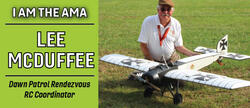Written by John Glezellis.
Find Part I on page 119 in the June 2012 issue.
Part II Interview with QuiQue Somenzini.
JG: I know that you have designed quite a few airplanes, not only when you had your own aircraft business, but now, working for Horizon Hobby Distributors. What is your typical day like? QS: In the past, I had my own airplane business, (Quique’s Aircraft Company), and enjoyed working with Wayne Ulery in owning [the] company together. We brought to the market many good airplanes that people enjoyed, which meant a lot to us. Now, I work for Horizon Hobby Distributors, but things are pretty similar!
People often see Horizon Hobby Distributors as a large company, and believe me, it is! However, the projects I work on are driven by my personal passion. In fact, each of the developers at Horizon has a passion for the hobby, and in that sense, it is similar to the work ethics I had when I was working for my own company.
Now I live in Champaign, Illinois, and about 2 miles from Horizon. This is pretty exciting for me, as I can’t wait to come to work every day. Like I said earlier, it is similar to when I worked for myself, as the “drive” is there. Now, I can interact with more people to further show my ideas and how they can have an impact on others. Honestly, I could not ask for a better situation. JG: While working for Horizon Hobby Distributors, what has been your favorite design and why?QS: So far, my favorite design has been the new Firebird Stratos. Yes, I know, it is a trainer model! However, it is very special [to] me, as I wanted to work on a project for my sons to learn how to fly on!JG: I know that many modelers may not be aware of the amount of time and thought that goes into a production model. Approximately how long does it take to make a model, from the first design thoughts to actual production?QS: From an idea, it can take anywhere between 12 and 18 months to develop a product enough to enter the market, and this, of course, depends on the complexity of the aircraft. While it seems like a long time, it involves a large group of people who need to coordinate many different aspects of the business. For example, time isn’t only spent on developing and producing the airplane. A large amount of time extends into the business aspect, like marketing, purchasing, sales, etc. Everyone needs to work together to ensure that everything is complete by the time the product is initially released into the market. JG: Aside from flying, what other hobbies and/or interests do you have?QS: Being from Argentina, it is only natural that I enjoy soccer. My two older sons play soccer, and we often play together. When I was younger, I enjoyed running as well.
Another pastime of mine is watching Formula 1 racing, and lately (while still being related to flying), I have had a large interest in flying RC jets.JG: I know that you have a few children. Have they shown an interest in flying? QS: Sandra and I have three children. Luciano is eight, Sebastian is five, and Nicolas is four-months old.Luciano showed an interest in flying, and that is how I started thinking about the initial concept behind the Firebird Stratos. I wanted to design and make a trainer for him to learn how to fly on. While he enjoys flying, he has taken a liking to the mechanical parts that make the airplane fly. Sebastian is also enthusiastic in flying. Do I expect them to all be fliers? While that would be good, it really depends on them. Of course, I can only hope!








Similar Articles
 Interview with Somenzini about Stratos
Interview with Somenzini about StratosBy Jenni Orebaugh and Jay Smith. Online exclusive text, videos, and photos.

Written and designed by Fred Randall Online exclusive plans-build article. Download the entire plans for free.

Written by Mark Fadely Find the entire feature on page 16 in the October 2011 issue. Read an abridged summary as well as online exclusive photos from the event.







Comments
Add new comment